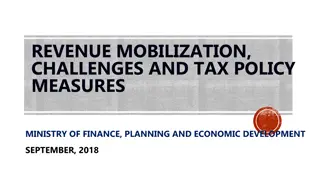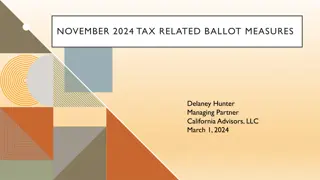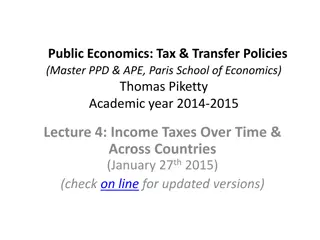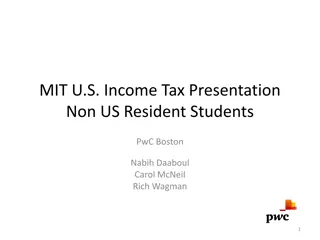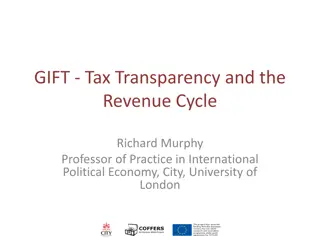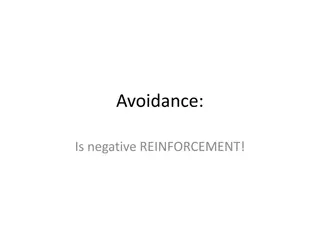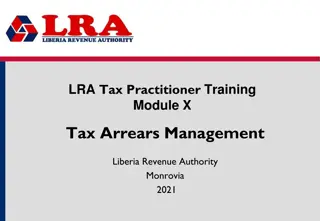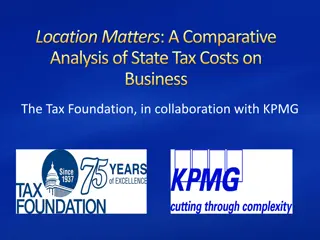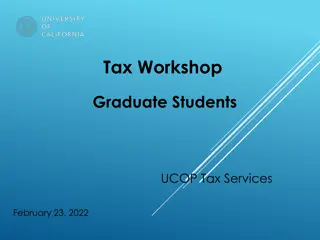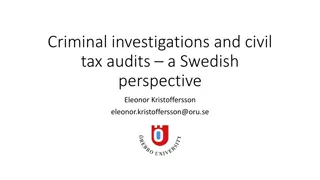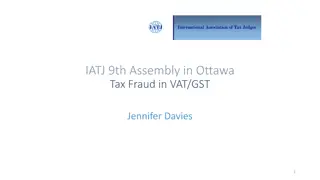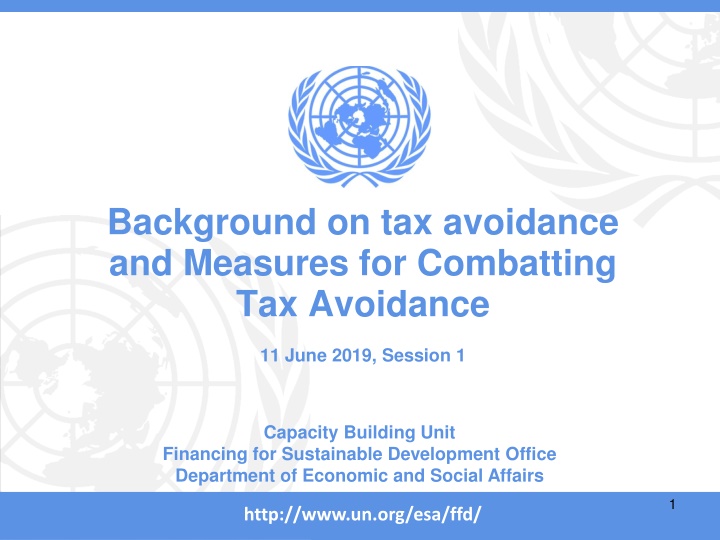
Tax Avoidance and Combat Measures
Tax avoidance is a complex issue with various forms and implications. Learn about the distinctions between legitimate and unacceptable practices, types of tax avoidance, common strategies used, and the causes that contribute to this behavior.
Download Presentation

Please find below an Image/Link to download the presentation.
The content on the website is provided AS IS for your information and personal use only. It may not be sold, licensed, or shared on other websites without obtaining consent from the author. If you encounter any issues during the download, it is possible that the publisher has removed the file from their server.
You are allowed to download the files provided on this website for personal or commercial use, subject to the condition that they are used lawfully. All files are the property of their respective owners.
The content on the website is provided AS IS for your information and personal use only. It may not be sold, licensed, or shared on other websites without obtaining consent from the author.
E N D
Presentation Transcript
Background on tax avoidance and Measures for Combatting Tax Avoidance 11 June 2019, Session 1 Capacity Building Unit Financing for Sustainable Development Office Department of Economic and Social Affairs 1 http://www.un.org/esa/ffd/
Definition of tax avoidance Difficult to define precisely Not all reductions of tax are offensive In most countries, taxpayers have the right to arrange their affairs to minimize tax 2
Distinction between acceptable and unacceptable tax avoidance Various terms used to describe the distinction: Legitimate/illegitimate Permissible/impermissible Abusive Normal/abnormal Artificial Distinction must be made by taxpayers and their advisers, then tax officials, and finally the courts 3
Distinction between tax avoidance and tax evasion Tax evasion: intentional non-payment or underpayment of tax through fraud, non- disclosure or misrepresentation Criminal offence punishable by fines or imprisonment Tax avoidance: reduction of tax legally (i.e., no fraud, non-disclosure or misrepresentation) Some tax avoidance may not be successful because of specific rules or court decisions Some tax avoidance is acceptable and some is unacceptable Tax avoidance is not usually illegal 4
Types of tax avoidance Purely domestic tax avoidance transactions Cross-border tax avoidance transactions Tax avoidance through the use of tax treaties 5
Common types of tax avoidance Transfer pricing of intercompany transactions Use of holding companies Diverting income to controlled entities in low-tax jurisdictions Converting income into capital gains Altering the character of payments Use of hybrid entities and instruments 6
Causes of tax avoidance Taxpayers right to minimize tax Inadequate legislation Inadequate enforcement Aggressive taxpayers and tax advisers Literal interpretation of tax legislation by courts Adherence to legal form of transactions 7
Extent of tax avoidance OECD BEPS Action 11 Measuring and Monitoring BEPS (2015): Although measuring the scale of BEPS proves challenging given the complexity of BEPS and the serious data limitations, today we know that the fiscal effects of BEPS are significant. The findings of the work performed since 2013 highlight the magnitude of the issue, with global corporate income tax (CIT) revenue losses estimated between 4% and 10% of global CIT revenues, i.e. USD 100 to 240 billion annually. Given developing countries greater reliance on CIT revenues, estimates of the impact on developing countries, as a percentage of GDP, are higher than for developed countries. Lack of evidence of the extent of tax avoidance does not mean it doesn t exist or isn t large 8
Experience of Trinidad and Tobago What are typical forms of tax avoidance in Trinidad and Tobago? What are typical measures used in other countries to address these forms of tax avoidance? 9
Strategies for combatting tax avoidance The role of the legislature Specific anti-avoidance rules Mandatory disclosure rules General anti-avoidance rule The role of the tax authorities The role of the courts 10
The role of the legislature Adoption of specific anti-avoidance rules to deal with domestic and cross-border tax avoidance Cross-border rules deal with inbound and outbound avoidance, or with both Examples of cross-border rules: Transfer pricing rules Thin capitalization or earnings-stripping rules Controlled foreign corporation (CFC) rules Surplus-stripping rules Effectiveness? Adoption of a GAAR 11
Mandatory disclosure rules All anti-avoidance rules require tax authorities to have information about questionable transactions Difficult for tax authorities to gather the necessary information Therefore, some countries require taxpayers to disclose information about transactions that meet certain criteria BEPS Action 12 provides guidance 12
Mandatory disclosure rules Persons required to report Promoters and taxpayers Promoter is person who designs, sells, finances, manages, etc., or makes representations about a scheme 13
Transactions that must be reported Threshold requirements: main benefit of scheme is tax reduction; de minimis amount Hallmarks: Confidentiality Contingent fees Tax indemnities Mass marketing Certain high-risk transactions (losses, leasing, tax havens, hybrids) 14
Mandatory disclosure rules Timing of disclosure Identification of investors Information reported: Name of promoter or taxpayer Features of scheme and expected tax benefits Statutory provisions relied on List of clients Penalties 15
Role of the tax authorities Requires adequate human resources and one or more specialized tax avoidance units Requires power to gather information from taxpayers and third persons Mandatory disclosure rules (see above) International cooperation 16
Role of the courts Do courts play an active role in preventing tax avoidance, or not? Courts in some countries have developed judicial doctrines to prevent tax avoidance Piercing the corporate veil Ineffective transactions Sham transactions Substance-over-form Step transactions Business purpose test Uncertainty; requires knowledgeable judges 17
Role of the courts Overall judicial context may make judges more/less likely to adopt anti-avoidance doctrines Approaches to the interpretation of tax legislation Literal interpretation facilitates tax avoidance Broad approach considers text, context, purpose and consequences Adherence to legal form of transactions or consideration of economic substance Judges understanding of tax rules and policy 18
General Anti-Avoidance Rule (GAAR) Unlike specific anti-avoidance rules, a GAAR is intended to apply to all types of transactions and arrangements, all types of taxpayers, all types of taxes (PIT, CIT, capital gains tax) and all types of payments and receipts Attempt to discourage or prevent tax avoidance before it occurs rather than dealing with it after it happens 19
Is a GAAR necessary? What is the extent of unacceptable tax avoidance? Difficult to measure Is a GAAR consistent with the rule of law and constitutional principles? Are specific anti-avoidance rule adequate? Are judicial anti-avoidance doctrines adequate? Is a GAAR too uncertain? 20
Is a GAAR Necessary? Most countries have concluded that a GAAR is necessary Specific rules are inadequate Extensive tax avoidance undermines public confidence in the tax system and fairness A GAAR can be judicial or statutory Most countries do not have well developed judicial anti-avoidance doctrines Therefore, a statutory GAAR is the only feasible option 21
Thank you TaxffdCapDev@un.org 22 http://www.un.org/esa/ffd/


![Town of [Town Name] Real Estate Tax Rates and FY 2024 Budget Summary](/thumb/62211/town-of-town-name-real-estate-tax-rates-and-fy-2024-budget-summary.jpg)




